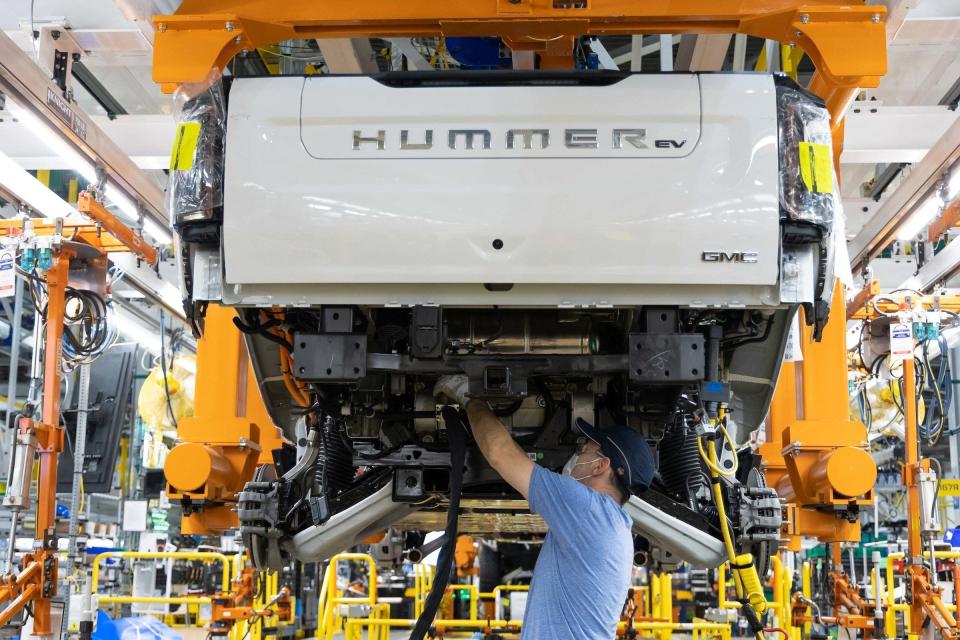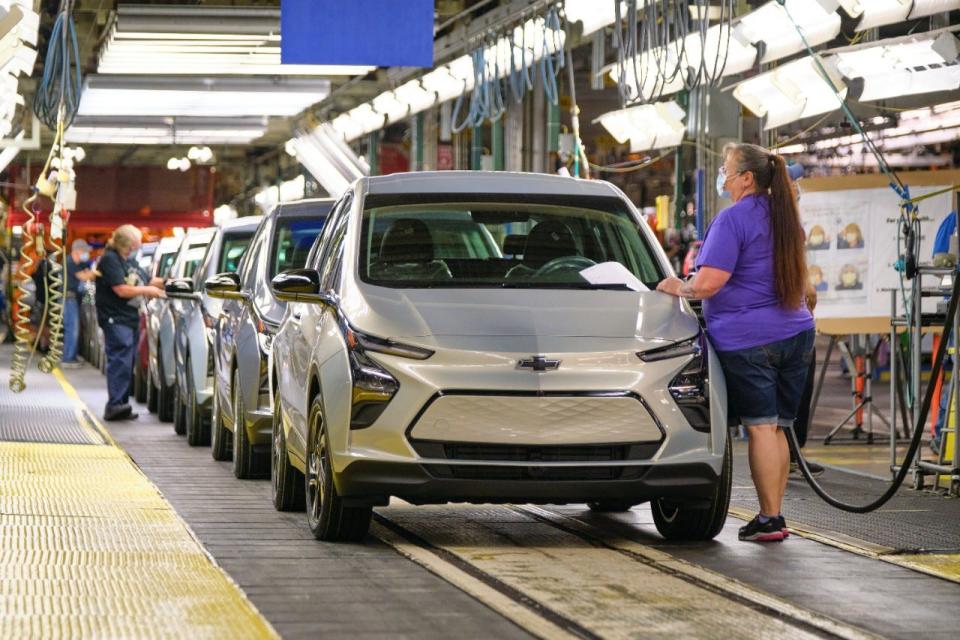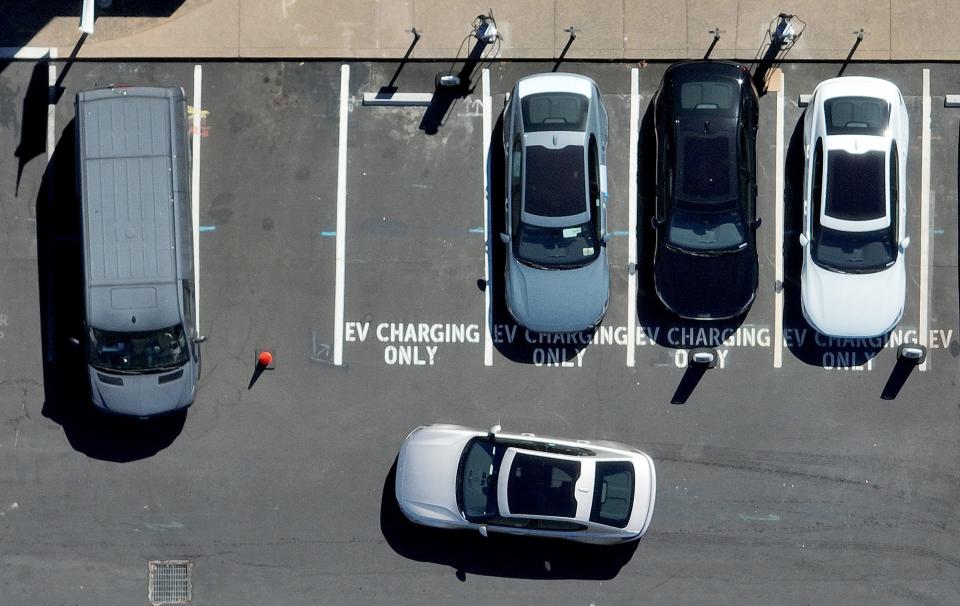Forget the UAW strike, the real crisis may be a lack of demand for EVs
One year ago, most car dealers could sell an electric vehicle within a few weeks. Today, data shows those vehicles linger longer than a month, gathering dust on dealership lots, despite lower transaction prices, a federal tax credit available on many and attractive leasing options.
The slowdown in consumer demand for EVs has not gone unnoticed by General Motors.
CEO Mary Barra said Tuesday that GM would withdraw its target of making 400,000 EVs for 2022 through June 2024. GM still plans to end 2025 with 1 million units of North American EV capacity, but Barra said if the demand is not there for 1 million EVs, GM will not build them.

“As we get further into the transition to EVs, it gets a bit bumpy, which is not unexpected," Barra told analysts during a third-quarter conference call Tuesday, emphasizing GM remains committed to its goal of an all-electric lineup by 2035. "GM will be agile to make sure the portfolio is in the right segments ... and we have the right entrants that people want to buy.”
On Wednesday, Honda and GM ended their partnership to build affordable EVs, citing business uncertainties. Even EV market leader Tesla reported third-quarter net income of $1.85 billion down from $3.29 billion in the year-ago period. It has since lowered prices to move inventory this quarter, according to Fortune.
GM exemplifies the dilemma many carmakers face. The early adopters who bought EVs have gone home and the remaining consumers are hitting pause on EV consideration amid economic uncertainty, the lack of a widespread and reliable charging network and continued higher prices for most EVs compared with gasoline-powered counterparts, industry experts said. According to Edmunds.com data, the average EV transaction price in September was $59,674, not including a $7,500 tax credit for those that are eligible. That compares with the industry average transaction price of $47,698.

For automakers that have invested billions of dollars to transition to an all-electric lineup — GM has invested $35 billion through 2025 — it creates a challenge to get returns on those investments anytime soon. Further complicating it are government-mandated emissions standards that can be met only by having a certain number of EVs in a lineup.
"Did the automakers overshoot the market here? Yes. But this is primarily driven by regulation," said Jeff Windau, equities analyst for Edward Jones in St. Louis, Missouri. "The government is coming out with emissions regulations and mileage regulations and really pushing automakers to achieve those or pay penalties. The only way to achieve that is with electric vehicles. It’s a Catch-22. You may not have the broad consumer demand at this point, but you need to do it otherwise you have regulations to deal with."
Tougher rules around the corner
As it stands right now, there are no formal federal mandates requiring automakers to make or sell a certain number or percentage of electric vehicles, even though President Joe Biden did, back in 2021, sign a nonbinding executive order setting a target of having half of all new cars and light-duty trucks sold in by 2030 emit zero greenhouse gas emissions.
More important, both the Environmental Protection Agency (EPA) and the National Highway Traffic Safety Administration (NHTSA) have proposed rules for cars and trucks under different federal laws that, if finalized next year as expected, would virtually require automakers to hit that target or higher by 2032. Otherwise, they’d have to find some other way to hit those targets or pay massive fines.

The EPA’s proposed limits on greenhouse gas emissions from vehicles beginning with model year 2027 are so strict, for instance, it could virtually mandate that, in a decade’s time from now, two-thirds of all the new cars sold would be electric. And NHTSA’s proposed rules promote much the same goal, with a whopping 58 mpg average for cars and light-duty trucks (compared with about 35.5 mpg this year) contemplated by 2032. And that’s not all: A change by the U.S. Energy Department being floated that would significantly reduce what’s called the petroleum equivalency factor or PEF — which effectively allows automakers to count EVs against gas guzzlers in their fleets at a much higher rate currently when their average fuel efficiency is being calculated — is expected to cost manufacturers, especially the Detroit Three, billions as compared with automakers with fleets of smaller (and often imported) cars.
That last change, especially, has Detroit automakers scratching their heads, since they made many of their most recent investments in EVs believing that those larger credits would offset higher emissions and lower mpg ratings of their other trucks and SUVs.
'A remarkable turn of fortune'
According to Edmunds.com data, in September 2022, the average number of days an EV sat on a dealership lot before it sold was 21. Last month, it was 65 days.
"EVs were at one point the fastest-selling vehicles on a dealer's lot; now becoming the slowest seller is not confidence inspiring," said Ivan Drury, Edmunds’ director of insights.

At Cox Automotive, data shows consumers paid a $10,000 to $15,000 premium on EVs in recent years, said Stephanie Valdez Streaty, director of industry insights at Cox Automotive. The most recent data shows there’s a less than $3,000 premium paid for an EV compared with an internal combustion engine vehicle, she said.
Automakers increased production of EVs to give consumers more selection and pricing relief, Drury said, but consumers sentiment for EVs has taken "a remarkable turn of fortune versus last year when consumers were buying these vehicles with sight unseen, no test drive and paying over sticker. Now you have dealers that can't even get rid of these with both automaker- and government-backed assistance."
Edmunds data shows the lease penetration rate for EVs was much higher in September this year, at 58%, compared with the year-ago period at 7%. Drury said that means automakers are using leasing to get payments as low as possible to help move these vehicles off the lot. There are some EVs that qualify for automakers to pass along a tax credit.
He said Edmunds data shows that the average discount in September on a leased EV was about $3,602 off the sticker price compared with a year ago when people paid about $1,438 over sticker. That, along with those EV tax credits some carmakers pass on to leasees, contributes to about a $300 lower monthly payment on an EV priced at about $63,000.
But Drury said higher interest rates kill interest in EV purchases, not just because it makes ownership costs higher, but because high interest rates are supposed to cause risk adverse purchasing and investing behavior.

"That translates into buying more time-tested products and, with autos, that is internal combustion engine not EV," Drury said. "As for GM specifically, 2023 is a wakeup call, EVs are not insulated from the larger issues that surround the automotive industry, in fact, they're more susceptible to factors that are beyond the control of the automaker."
Drury said it is still possible that GM's Buick and Cadillac brands will offer only EVs by 2030, as GM planned. But it doesn't mean that people will be buying them.
"GM, like many automakers, are more than likely going to be reevaluating the course they've plotted for EV dominance," Drury said.
GM's and Ford's EV strategy tweaks
Ford Motor Co. is tweaking its electric strategy. CEO Jim Farley said in July that after hearing consumers express apprehension about all-electric vehicles, he adjusted company strategy. Ford plans to continue its push into hybrid vehicles, which use both gasoline and battery power, to accommodate consumers who want to slow down their pending divorce from the traditional fuel pump, Farley revealed after second-quarter earnings.
Farley also dialed back the Ford forecast to produce 600,000 EVs annually by 2024 rather than by 2023. He spotlighted hybrids, which increase fuel efficiency for truck owners while allowing them to go to the gas pump in times of need rather than find a charging station to plug in.
On Thursday, Ford said in its third-quarter earnings call that it is reevaluating its speed of investment in EVs, though it is "not moving away" from its next generation of electric products. But the company is balancing consumer demand and volumes produced. It will delay about $12 billion in capital investments related to EV production.

"Hybrids are a good option for people as they transition to electric," said Cox's Valdez Streaty. "But the amount of money that has been allocated toward EVs, we’re going to continue down that road. But it might not continue at the same pace. It might speed up or slow down as the market changes."
Since Biden's Inflation Reduction Act took effect in August 2022, Valdez Streaty said, automakers and battery makers have said they plan to invest a total of about $92 billion on electrification of cars in the United States.
At GM, Barra said Tuesday it will push back the launches of the Chevrolet Equinox EV and the Chevrolet Silverado RST EV "by a few months." That comes after GM announced a one-year postponement in production of the retail Silverado EV and GMC Sierra EV pickups at Orion Assembly plant in Orion Township — a move that delays $1.5 billion in capital spending. GM builds the Chevrolet Bolt and Bolt EUV at Orion now and will end that production at the end of the year. GM will revive the Bolt later on the Ultium propulsion system, but it has not said where it will build the Bolt or when it will come back on the market.

"We are reducing our fixed costs by $2 billion net of depreciation and amortization as we exit 2024," Barra said. "We are also moderating the acceleration of EV production in North America to protect our pricing, adjust to slower near-term growth in demand, and implement engineering efficiency and other improvements that will make our vehicles less expensive to produce, and more profitable."
GM will continue to build the Silverado EV work truck at Factory Zero, which straddles the Detroit-Hamtramck border.
Investors exercise patience
Morningstar Equities Analyst David Whiston said in a research note, "We are not bothered by this slowing because GM still makes ample profit on its combustion portfolio and more charging infrastructure is coming next year."
Plus, said Edward Jones' Windau, GM has the challenge of transitioning from a very profitable category of gasoline vehicles to electric vehicles, which are not profitable yet. "So you can understand wanting to slow up a bit especially in an uncertain economy," he added.
Both agreed there needs to be more charging infrastructure and more affordable EVs, and GM is working on doing both for 2024. It is rolling out the Chevrolet Equinox EV next year, expected to start at about $30,000, and, like Ford, GM is partnering with Tesla to integrate the North American Charging Standard (NACS) connector design into its EVs beginning in 2025. That will give EV owners access to some 12,000 more chargers throughout North America.
GM continues to work with others in the industry to accelerate the installation of various charging networks including its collaborations with Pilot Company and EVgo that will add more than 5,000 DC fast chargers to the nearly 13,000 existing DC fast chargers in North America. GM will put community chargers throughout the U.S. and Canada.
Also, there will be 50 new EVs out next year across the industry, so consumers will see different vehicles in different price points, which should spur sales, said Cox's Valdez Streaty.
"It’s a huge transformation, but the industry is committed to it," she said.
Charger fear, advancing technology
Now that the early adopter phase is past, the industry is in a phase Valdez Streaty calls "early majority space." It is where the automakers, through their dealers, have to educate the majority of consumers on EVs to show them the value of owning one.

“The whole infrastructure is a big thing," Valdez Streaty said. "We used to hear about range anxiety, but I think it’s now charger anxiety — where can I find a charger? Will it be operational?”
Charger station fear is real, said Erik Gordon, business professor at University of Michigan's Ross School of Business. But so is concern among consumers about advancing technology that would outdate their purchase.
"The billions being spent on today’s EV technology platforms, might not be the best technology five years out," Gordon said. And if there is a technology shift in five years, he said, a surge in EV sales will follow and that's when the automakers might finally see a return on their investment.
But until consumers get past that worry and the fear of infrastructure, or lack thereof, no incentives will spur EV sales, most experts say. Just ask Bill Klehm, CEO of eBliss Global, a startup manufacturer of electric bikes to be sold at car dealerships in North America. Klehm drives a Ford Lightning EV and said he regrets buying it because of a lack of infrastructure to charge it.

"Even detailed planning on routes, it’s completely unpredictable. The infrastructure is such an inconvenience that it’s spoiling the engineering and design that’s gone into these beautiful vehicles," Klehm said. "You’re putting the consumer in a position where they’re so uncomfortable with their experience — the cars are great — but if you can’t put energy into the car in what consumers view is a normal way, they’re reacting."
Free Press staff writers Todd Spangler and Phoebe Wall Howard contributed to this report.
Contact Jamie L. LaReau: jlareau@freepress.com. Follow her on Twitter @jlareauan. Read more on General Motors and sign up for our autos newsletter. Become a subscriber.
This article originally appeared on Detroit Free Press: Forget the strike, the real crisis could be a lack of demand for EVs